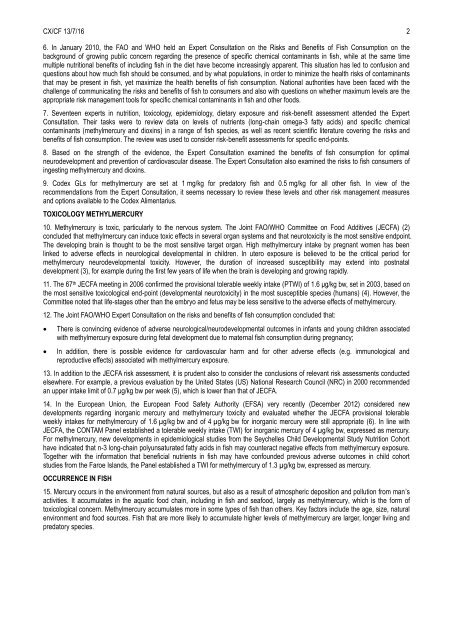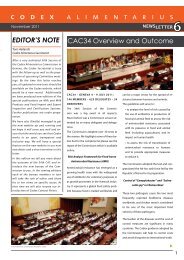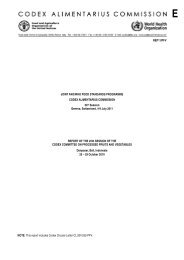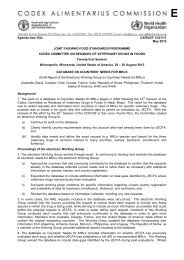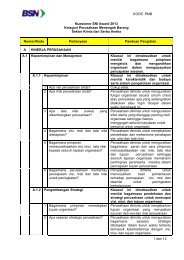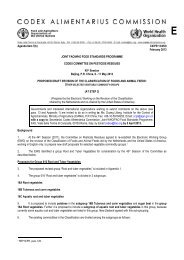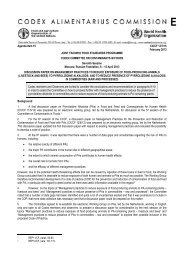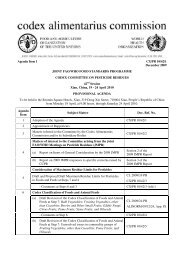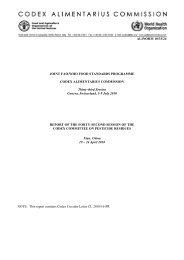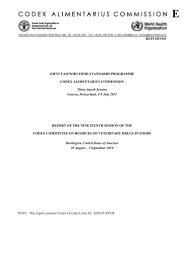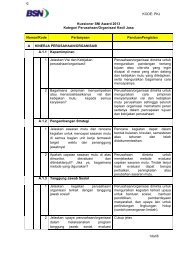Agenda Item 16 CX/CF 13/7/16 February 2013 JOINT FAO ... - FAO.org
Agenda Item 16 CX/CF 13/7/16 February 2013 JOINT FAO ... - FAO.org
Agenda Item 16 CX/CF 13/7/16 February 2013 JOINT FAO ... - FAO.org
- No tags were found...
Create successful ePaper yourself
Turn your PDF publications into a flip-book with our unique Google optimized e-Paper software.
<strong>CX</strong>/<strong>CF</strong> <strong>13</strong>/7/<strong>16</strong> 26. In January 2010, the <strong>FAO</strong> and WHO held an Expert Consultation on the Risks and Benefits of Fish Consumption on thebackground of growing public concern regarding the presence of specific chemical contaminants in fish, while at the same timemultiple nutritional benefits of including fish in the diet have become increasingly apparent. This situation has led to confusion andquestions about how much fish should be consumed, and by what populations, in order to minimize the health risks of contaminantsthat may be present in fish, yet maximize the health benefits of fish consumption. National authorities have been faced with thechallenge of communicating the risks and benefits of fish to consumers and also with questions on whether maximum levels are theappropriate risk management tools for specific chemical contaminants in fish and other foods.7. Seventeen experts in nutrition, toxicology, epidemiology, dietary exposure and risk-benefit assessment attended the ExpertConsultation. Their tasks were to review data on levels of nutrients (long-chain omega-3 fatty acids) and specific chemicalcontaminants (methylmercury and dioxins) in a range of fish species, as well as recent scientific literature covering the risks andbenefits of fish consumption. The review was used to consider risk-benefit assessments for specific end-points.8. Based on the strength of the evidence, the Expert Consultation examined the benefits of fish consumption for optimalneurodevelopment and prevention of cardiovascular disease. The Expert Consultation also examined the risks to fish consumers ofingesting methylmercury and dioxins.9. Codex GLs for methylmercury are set at 1 mg/kg for predatory fish and 0.5 mg/kg for all other fish. In view of therecommendations from the Expert Consultation, it seems necessary to review these levels and other risk management measuresand options available to the Codex Alimentarius.TOXICOLOGY METHYLMERCURY10. Methylmercury is toxic, particularly to the nervous system. The Joint <strong>FAO</strong>/WHO Committee on Food Additives (JE<strong>CF</strong>A) (2)concluded that methylmercury can induce toxic effects in several <strong>org</strong>an systems and that neurotoxicity is the most sensitive endpoint.The developing brain is thought to be the most sensitive target <strong>org</strong>an. High methylmercury intake by pregnant women has beenlinked to adverse effects in neurological developmental in children. In utero exposure is believed to be the critical period formethylmercury neurodevelopmental toxicity. However, the duration of increased susceptibility may extend into postnataldevelopment (3), for example during the first few years of life when the brain is developing and growing rapidly.11. The 67 th JE<strong>CF</strong>A meeting in 2006 confirmed the provisional tolerable weekly intake (PTWI) of 1.6 μg/kg bw, set in 2003, based onthe most sensitive toxicological end-point (developmental neurotoxicity) in the most susceptible species (humans) (4). However, theCommittee noted that life-stages other than the embryo and fetus may be less sensitive to the adverse effects of methylmercury.12. The Joint <strong>FAO</strong>/WHO Expert Consultation on the risks and benefits of fish consumption concluded that:There is convincing evidence of adverse neurological/neurodevelopmental outcomes in infants and young children associatedwith methylmercury exposure during fetal development due to maternal fish consumption during pregnancy;In addition, there is possible evidence for cardiovascular harm and for other adverse effects (e.g. immunological andreproductive effects) associated with methylmercury exposure.<strong>13</strong>. In addition to the JE<strong>CF</strong>A risk assessment, it is prudent also to consider the conclusions of relevant risk assessments conductedelsewhere. For example, a previous evaluation by the United States (US) National Research Council (NRC) in 2000 recommendedan upper intake limit of 0.7 μg/kg bw per week (5), which is lower than that of JE<strong>CF</strong>A.14. In the European Union, the European Food Safety Authority (EFSA) very recently (December 2012) considered newdevelopments regarding in<strong>org</strong>anic mercury and methylmercury toxicity and evaluated whether the JE<strong>CF</strong>A provisional tolerableweekly intakes for methylmercury of 1.6 µg/kg bw and of 4 µg/kg bw for in<strong>org</strong>anic mercury were still appropriate (6). In line withJE<strong>CF</strong>A, the CONTAM Panel established a tolerable weekly intake (TWI) for in<strong>org</strong>anic mercury of 4 µg/kg bw, expressed as mercury.For methylmercury, new developments in epidemiological studies from the Seychelles Child Developmental Study Nutrition Cohorthave indicated that n-3 long-chain polyunsaturated fatty acids in fish may counteract negative effects from methylmercury exposure.Together with the information that beneficial nutrients in fish may have confounded previous adverse outcomes in child cohortstudies from the Faroe Islands, the Panel established a TWI for methylmercury of 1.3 µg/kg bw, expressed as mercury.OCCURRENCE IN FISH15. Mercury occurs in the environment from natural sources, but also as a result of atmospheric deposition and pollution from man’sactivities. It accumulates in the aquatic food chain, including in fish and seafood, largely as methylmercury, which is the form oftoxicological concern. Methylmercury accumulates more in some types of fish than others. Key factors include the age, size, naturalenvironment and food sources. Fish that are more likely to accumulate higher levels of methylmercury are larger, longer living andpredatory species.


